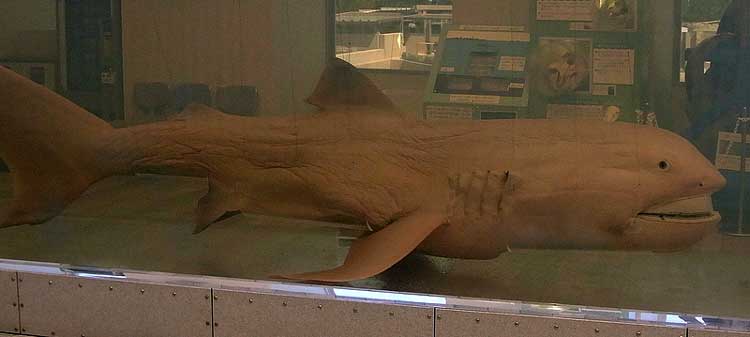Megachasma pelagios (*) Cladus: Eukaryota Vernacular Name The megamouth shark, Megachasma pelagios, is an extremely rare species of deepwater shark. Since its discovery in 1976, only a few megamouth sharks have been seen with 50 specimens known to have been caught or sighted as of 2010, including three recordings on film. Like the basking shark and whale shark, it is a filter feeder, and swims with its enormous mouth wide open, filtering water for plankton and jellyfish. It is distinctive for its large head with rubbery lips. It is so unlike any other type of shark that it is classified in its own family Megachasmidae, though it has been suggested that it may belong in the family Cetorhinidae of which the basking shark is currently the sole member. Physical characteristics The appearance of the megamouth is distinctive, but little else is known about it. It has a brownish-black color on top and is white underneath, and an asymmetrical tail with a long upper lobe, similar to the thresher shark. The interior of its gill slits are lined with finger-like gill rakers that capture its food. A relatively poor swimmer, the megamouth has a soft, flabby body and lacks keels. Megamouths are very large sharks, able to grow to 5.5 metres (18 ft) in length. Males mature by 4 metres (13 ft) and females by 5 metres (16 ft). Weights of up to 1,215 kilograms (2,680 lb) have been reported. As their name implies, megamouths have a large mouth with small teeth, and a broad, rounded snout, causing observers to occasionally mistake megamouth for a young orca. The mouth is surrounded by luminous photophores, which may act as a lure for plankton or small fish. Their mouths can reach up to 1.3 metres wide. Behaviour In 1990 a 4.9 meter (16 ft) male megamouth shark was caught near the surface off Dana Point in California. This individual was eventually released with a small radio tag attached to its soft body. The tag relayed depth and time information over a two day period. During the day the shark cruised at a depth of around 120–160 m (400–525 ft), but as the sun set, it would ascend and spend the night at depths of between 12 and 25 m (39–80 ft). Both day and night its progress was very slow at around 1.5–2.1 km/h (1–1.3 mph). This pattern of vertical migration is seen in many marine animals as they track the movement of plankton in the water body.[1] The shark captured in March 2009 was reportedly netted at a depth of 200 m (660 ft). Reproduction Reproduction is ovoviviparous, meaning that the young sharks develop in eggs that remain within the mother's body until they hatch. Discovery The first megamouth was captured on November 15, 1976 about 25 miles off the coast from Kaneohe, Hawaii when it became entangled in the sea anchor of a United States Navy ship. Examination of the 14-1/2 foot (4.5 m), 1650 lb (750 kg) specimen by Leighton Taylor showed it to be an entirely unknown type of shark, making it one of the more sensational discoveries in 20th century ichthyology (see also coelacanth). Known specimens In the 30 years since its discovery, as of 2010 only 50 megamouth specimens have been caught or sighted. They have been found in the Pacific, Atlantic and Indian oceans. At least ten specimens have been found in the vicinity of each of Japan and Taiwan, more than any other single area. Specimens have also been pulled from the waters near Hawaii, California, the Philippines, Indonesia, Australia, Brazil, Senegal, South Africa, and Ecuador. On March 30, 2009 off Burias Island in the Philippines, a 880 - 1,100 pound (400- to 500-kilogram) 4-metre (13-foot) megamouth shark died while struggling in a fisherman's net and was subsequently taken to nearby Donsol in Sorsogon province, where it was examined by scientists, before being butchered and sold.[2][3][4]
1. ^ Piper, Ross (2007), Extraordinary Animals: An Encyclopedia of Curious and Unusual Animals, Greenwood Press. * Compagno (2000). Megachasma pelagios. 2006. IUCN Red List of Threatened Species. IUCN 2006. www.iucnredlist.org. Retrieved on 10 May 2006. Database entry includes a brief justification of why this species is listed as data deficient
Source: Wikipedia, Wikispecies: All text is available under the terms of the GNU Free Documentation License |
|

